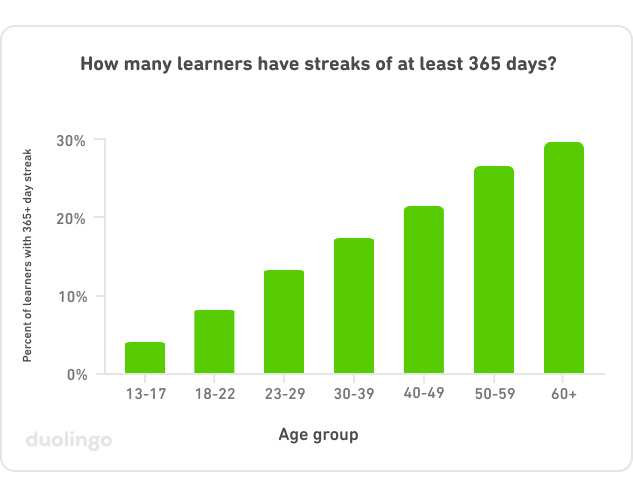Language learning can look really different across a person’s lifespan. There are some benefits to studying languages when you're younger, but adults can learn effectively, too. We also know that older adults who study a new language can see improvements in their cognitive health, and there's evidence that you never really forget a language you once learned.
How else do younger and older learners differ? To find out, we explored the study patterns of learners of different ages—in particular, how many have Duolingo streaks of 365 days or more.
The older the learner, the longer the streak
That’s right: More older learners have streaks of at least 365 days! Nearly 30% of learners age 60+ have year-long streaks, while less than 5% of learners 13-17 have reached the one-year mark.

We see a similar kind of commitment among Boomers who begin studying a language for their New Year's resolution. Learning a new language takes consistent effort, over a long period of time, so studying a little each day is more effective than binge-learning: It helps you better remember what you learn, and it gives your brain a chance to consolidate that knowledge!
The reasons that fewer younger learners have year-long streaks are complicated. Gen Z is especially interested in learning languages, so there may be a wider range of study habits among this large and diverse group of learners. Younger learners may also have difficulty crossing the one-year mark because of significant seasonal and life changes, including summer breaks, high school graduation, beginning college, and finding full-time work.
Older learners study different languages for different reasons
Older learners, on the other hand, often learn languages for different reasons than their younger counterparts. Travel is a popular reason for language study among Boomers and Gen X, and having a specific, personal goal (like an upcoming trip!) is a great way to stay motivated and develop consistent study habits. Using a language at your destination helps you connect with locals, so older learners might return from their vacations even more enthusiastic about language learning!
The importance of travel for older learners is likely related to their choice of languages as well: Naturally, many study the languages of their favorite destinations. For example, in the U.S., Spanish is the most popular language among learners 40 and older, followed by English, French, and Italian. However, Italian ranks 2 to 3 spots lower for learners 13-39!
Learners' streaks are getting better with age!
Older learners are showing they've got what it takes to build strong study habits that will help them develop language skills no matter their goal. Their commitment to their streaks keeps them coming back to learn day after day!



